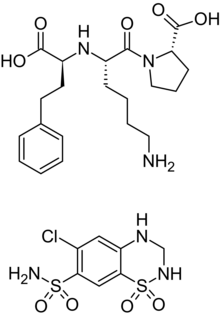Pharmaceutical compound
 Lisinopril (top) and hydrochlorothiazide (bottom) Lisinopril (top) and hydrochlorothiazide (bottom) | |
| Combination of | |
|---|---|
| Lisinopril | ACE inhibitor |
| Hydrochlorothiazide | Thiazide diuretic |
| Clinical data | |
| Trade names | Zestoretic, Prinzide, others |
| Other names | lisinopril/hctz |
| AHFS/Drugs.com | Micromedex Detailed Consumer Information |
| MedlinePlus | a601070 |
| License data | |
| Pregnancy category |
|
| Routes of administration | By mouth |
| ATC code | |
| Legal status | |
| Legal status | |
| Identifiers | |
| CAS Number | |
| KEGG | |
| (verify) | |
Lisinopril/hydrochlorothiazide, sold under the brand name Zestoretic among others, is a fixed-dose combination medication used for the treatment of high blood pressure (hypertension). It contains lisinopril, an ACE inhibitor, and hydrochlorothiazide, a diuretic. Typically, it becomes an option once a person is doing well on the individual components. It is taken by mouth.
Common side effects include dizziness, headache, cough, and feeling tired. Severe side effects may include angioedema and low blood pressure. Use during pregnancy may harm the baby.
The combination was approved for medical use in the United States in 1989. It is on the World Health Organization's List of Essential Medicines. It is available as a generic medication. In 2022, the combination was the 53rd most commonly prescribed medication in the United States, with more than 12 million prescriptions.
Medical uses
Lisinopril/hydrochlorothiazide is indicated for the treatment of hypertension, to lower blood pressure.
Adverse effects
The US Food and Drug Administration prescription label for the combination contains a boxed warning about harm to the baby.
References
- "Product monograph brand safety updates". Health Canada. February 2024. Retrieved 24 March 2024.
- ^ "Zestoretic- lisinopril and hydrochlorothiazide tablet". DailyMed. Retrieved 9 February 2022.
- ^ "Hydrochlorothiazide and lisinopril Uses, Side Effects & Warnings". Drugs.com. Cerner Multum. Retrieved 26 December 2018.
- ^ British national formulary : BNF 74 (74 ed.). British Medical Association. 2017. p. 166. ISBN 978-0857112989.
- World Health Organization (2023). The selection and use of essential medicines 2023: web annex A: World Health Organization model list of essential medicines: 23rd list (2023). Geneva: World Health Organization. hdl:10665/371090. WHO/MHP/HPS/EML/2023.02.
- "The Top 300 of 2022". ClinCalc. Archived from the original on 30 August 2024. Retrieved 30 August 2024.
- "Hydrochlorothiazide; Lisinopril Drug Usage Statistics, United States, 2013 - 2022". ClinCalc. Retrieved 30 August 2024.
This antihypertensive-related article is a stub. You can help Misplaced Pages by expanding it. |